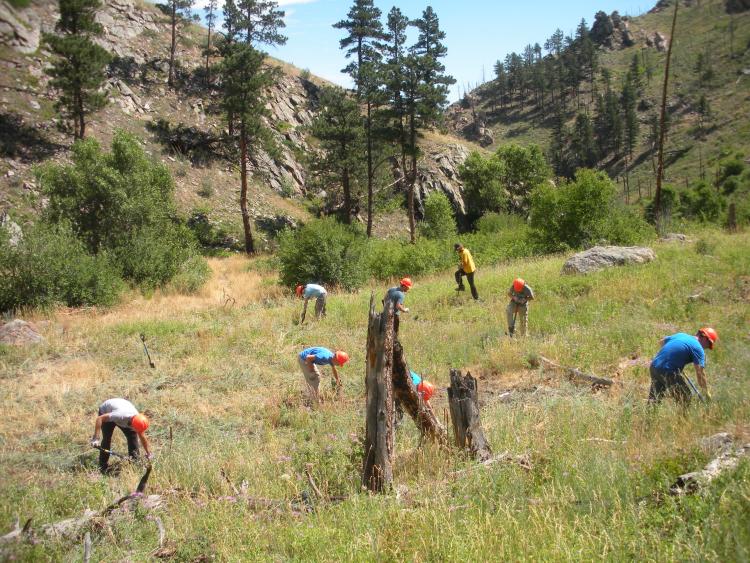Spruce Gulch land gift enhances future ecological and academic studies at CU Boulder
CU Boulder has received a momentous 476-acre land gift, the Spruce Gulch Wildlife and Research Reserve, alongside endowment funds to support ecological and academic work at the site. Donated by Linda Holubar Sanabria (A&S’67), the gifts are valued at a combined total of $10.4 million and managed by the university’s Institute of Arctic and Alpine Research (INSTAAR). INSTAAR’s faculty and students have conducted research at the Spruce Gulch Reserve for almost 25 years, and the gifts will support current and future on-site studies across the sciences, humanities and fine arts.
The donated land, located in Boulder County, was previously owned by Holubar’s family for almost 100 years. Holubar’s grandmother, Irma Freudenberg, purchased part of it in 1927, and Holubar’s parents, Alice (A&S’33) and LeRoy Holubar (ElEngr’36), expanded it. The site was once hunting grounds for Indigenous peoples like the Arapaho, but later sustained mining and logging operations, grazing and agriculture, plus wildfires and floods.
After inheriting the land in 1994 and managing it as a natural reserve since 2001, Holubar and her spouse, Sergio Sanabria (A&S’66; Arch’70; MArtHist’75), concluded a conservation easement with the county prior to donating the site to CU Boulder. The wildlife reserve and endowment funds were officially transferred to the university on June 24.
“Our gift to the university was conditional on the easement and additional preservation terms,” said Holubar. “Having grown up on this land and having it be a part of my family for almost a century, I view it as my heart and soul and want nothing more than to protect it.”
The donations consolidate Holubar’s dedication to environmental conservation and CU Boulder’s long-standing relationship with the wildlife reserve.
“The Spruce Gulch property has had a real impact on CU Boulder research studies over the years, and it’s inspiring to consider the ways in which this will continue to grow,” said Chancellor Justin Schwartz. “Through her land and endowment gifts, Linda Holubar is fostering hands-on learning opportunities and strengthening the university as a leading research institution.”
A symbiotic friendship
For nearly 25 years, CU Boulder has carried out ecological research studies on the Spruce Gulch Reserve, led by ecology and evolutionary biology Professor Emeritus Tim Seastedt from INSTAAR. The university’s symbiotic relationship with the land began in 2001, when Holubar contacted Seastedt for assistance with an invasive plant on the land.
“My lab had just reported the results of a successful demonstration project, in which biological control insects could reduce densities of a particular weed infestation,” said Seastedt. “Those using this approach saved thousands of dollars in management costs.”
At the time, a similar plant was dominating over 50 acres of the Spruce Gulch Reserve. Seastedt and his lab group thought they could help while avoiding the use of toxic herbicides, which would have contaminated the drinking water and wells.
“Linda’s enthusiasm and persistence to use non-chemical management approaches was inspiring,” said Seastedt. “We organized volunteer groups to assist our insects and set up monitoring plots where the only treatment was the presence of the insects. The projects were often a lot of fun, empowering and certainly good exercise.”
Over time, and with the assistance of volunteer weeding efforts, the project proved successful and Holubar agreed to CU Boulder conducting more experiments on the property. As of early 2025, the Spruce Gulch site has aided CU faculty and students in research for 29 scholarly publications, plus chapters in six doctoral dissertations, three master’s theses and four undergraduate honors theses.

“Field ecologists don’t pass up opportunities to leverage a new field site, and this one is special,” said Seastedt, who serves as director of the reserve.
The varied landscape of the wildlife reserve includes canyons and cliffs intermixed with forest, savanna and prairie meadows. In addition to offering multiple research opportunities, the land also provides “solitude and adventure,” said Seastedt.
Land of possibilities
While CU Boulder has primarily used the property for ecology studies, the gifts open new educational possibilities across disciplines.
“Sergio was a professor of architecture for 42 years and understood the necessity of weaving many disciplines into his teaching,” said Holubar. “It seemed particularly important to extend that approach to a research site where ecology would be a central discipline. We wanted to discourage an inevitable disciplinary blindness by opening the site to as many different world views as possible.”
Holubar’s long-term vision for the wildlife reserve is that its complex landscape offers intellectual and creative opportunities across the university. The reserve and its endowment will enrich and support studies by academics of many departments—from biologists to visual artists. CU affiliates and other local organizations can inquire with Seastedt about research, education and conservation initiatives and opportunities on the land, which is not open to the public.
The endowment will mainly fund student and faculty research projects, and it will also aid in the maintenance of access trails and the future construction of a modest educational center and research support facility.
Through her gifts, Holubar hopes CU Boulder will steward her family’s legacy of environmentalism into the future.
“The history of CU’s environmental efforts includes some of the largest and most significant contributions to our understanding of high-elevation systems,” said Seastedt. “The acquisition of Spruce Gulch now allows us to pursue essential science relevant to the grasslands and foothills region, where most of us live. Therein lies the magnitude of this gift.”
To learn more about the Spruce Gulch Wildlife and Research Reserve, or to inquire about research and conservation opportunities on the land, visit the INSTAAR Spruce Gulch Reserve webpage.


